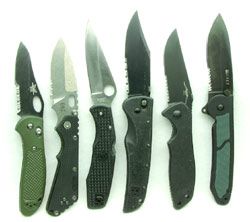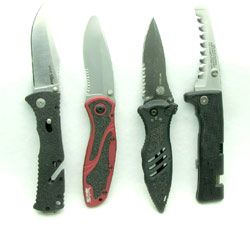Article updated on December 26, 2017
By Ralph Mroz
Let’s get to the bottom line right off the bat: Just about any folding knife from any of the several major manufacturers will serve reasonably well as a police tactical knife. That is if by police knife you mean a knife to be carried on duty for the random chores that we come across, which range from opening donut boxes to cutting down hanging victims.
Today there are more excellent knife manufacturers, skilled designers and high-service retail outlets operating in the industry than ever before. There are more knives available – from the mundane to the exotic – in better steels, with better quality and more innovative features than at any time in history.
Why do police officers need a duty knife?
A lot of companies market their knives to the police and to wannabes as weapons. Yes, knives are weapons, and ones that we face all the time on the street; but in terms of us using one as a weapon, well, that’s highly unlikely.
Not only do we have a whole Batman belt of force weapons at our disposal, but a knife is a deadly force weapon, and our sidearms are usually a better choice when deadly force is required, let alone a better tool to use from a public relations standpoint.
Some police officers are under the impression that they can use a knife to disable an attacker attempting to disarm their handgun. These officers need to try to do this at full force and full speed, as they will soon see it is highly unlikely.
On the other hand, there have been instances of officers saving their lives by using their own tactical knife on attackers, and instances of officers using a police knife to disable a gun-grab attempt. It’s just that it’s highly unusual.
All that being said, there is a definite place for the knife as a weapon in undercover operations (when the undercover officer can’t carry a gun) and on our own time when we either can’t be or aren’t armed with a gun.
Police officers really need a folding knife for the wide spectrum of chores it will perform. These chores involve scraping, cutting and prying. Chores like gathering evidence, opening contraband and jimmying locked containers. The knife ideally suited for this spectrum of utility chores is a simple spear-point or drop-point blade with a non-slip grip in a value-priced folding knife.
A great knife for uniformed officers is a rescue knife, which has a serrated, blunt blade for safely cutting webbing and clothing, and a carbide tip for breaking windows.
In our department an officer needed to break a car window in order to save an attempted suicide victim, but was unable to do so with the tools immediately at hand. The window punch that was supposed to be in the cruiser was missing, and our officer had to borrow a hatchet from a passing truck to break the car window and save the victim. A rescue knife would have solved the problem if he’d had one on him.
considerations when purchasing a police duty knife
Expect to pay $50 to $100 or even more for a good police duty knife. In general, you get what you pay for, but after a point you’re paying for looks or panache, not actual performance.
On the other hand, knives are very personal items, and there’s a great deal of pride of ownership with them. It’s no more foolish to buy a $500 custom knife that you really appreciate than it is to buy a $2500 custom pistol that you really appreciate.
Of course, anything really cheap is…well, really cheap, and may not even have hardened steel. Stick with the major brands or quality smaller companies, and avoid the knock offs.
Any modern blade steel from a quality manufacturer will serve you well. Each steel will have definite but not serious differences in performance on different materials, and they’ll have different edge-retention times.
You have to resharpen your knife sometimes anyway, and a little more often is hardly something to get upset about. For all-round utility work, remember that the more specialized the blade shape, the fewer tasks it will do well.
For defense work, choose a knife and blade shape that meshes with your police training (if you don’t have some, get some!)
knife locking mechanisms
Locking mechanisms vary, and they all have their trade-offs.
Test the lock by banging the blade spine against something hard several times to see if the lock holds (keep your fingers out of the way!)
Liner locks and lock-backs can disengage accidentally under the stress of a death grip (which is what you’ll have when you use it, no doubt.) To test, take a really tight grip on the opened knife, twist it around, and see if you can’t work some of your flesh into dis-engaging the locking mechanism. If so, choose another model.
Tang-locks can disengage accidentally when the blade point suddenly encounters something hard, which may cause the piston to jump backwards and release the blade.
Most knives are of the one-handed opening variety, whereby the knife is opened via a hole, stud or wafer in or on the blade. These knives are mechanically simple and have no mechanisms that can break.
Automatic knives (switchblades) are opened entirely by a spring via a release button.
Assisted opening knives are opened manually for the beginning part of the opening arc, and a spring takes over mid-way and throws the blade the rest of the way open.
Automatics are regulated by federal law, and you probably need specific permission from your agency to carry one on duty.
Knives will vary by the strength of the locking mechanism, which determines how much pressure the lock can take when force is applied directly to the back (spine) of the grip with the blade locked in a vice. However, any well-made knife will accept much more force along that vector than along the flat plane of the grip, and in real life there will be forces generated in every which direction.
Bottom line: The best police duty knife should be strong enough lock-wise (all bets are off, though, if you opt for a $12 special.) As the saying goes: “All folding knives start off life broken in the middle.”
how to Maintain a police duty knife
Knives are tools and need maintenance, albeit minimal. First, keep them clean. Wipe them down and flush them with water regularly, remembering to dry them thoroughly after the flushing with a hair dryer or rest-room hand dryer. Lubricate the pivot pin with a TINY drop of oil every now and then. For superb and inexpensive rust-resistance, wipe the blade with a Sentry Solutions Tuf-Cloth.
Sharpening a knife isn’t hard. Use a diamond or less expensive industrial bench stone. DMT and Norton make excellent diamond stones, and Norton’s Crystolon and India synthetic bench stones are probably the best on the market. One of the most common mistakes made is to choose too fine a bench stone. Working knives have blades that are quite hard and require a coarser stone for the initial passes than, say, kitchen cutlery. That’s why combination stones are so popular.
Another popular sharpening mechanism is the Spyderco Tri-Angle ceramic system and its clones. There’s a reason it is so popular: its easy to use and fool-proof. Any of these sharpening tools will last a lifetime, and they are an essential investment.
Standard Patrol Folders
A standard patrol folder is usually one with a three to four inch blade with a spear or drop-point shape. A partially serrated blade is useful for cutting the widest spectrum of materials. Non-slip grips, a comfortable feel and a good price point round out the bill.
 |
| Good mid-priced folders for all-round police work include (left to right): Benchmade Griptilian, Buck/Strider Tarani, Spyderco Endura, Cold Steel Recon, Emerson MAX 1, and Columbia River Knife & Tool M16. |
Larger Folding knives
A folder is “larger” if it has a greater than four-inch blade or a larger than “usual” handle, or both. These knives are well suited to law enforcement jobs where bigger things may need to be cut, such as in outdoor or wilderness patrol. Also these folders can be carried in a gear bag on any assignment on a “just in case” basis.
Automatic knives
Automatics, or switchblades, are regulated by federal law and most state laws, but there’s usually an exception for law enforcement. The upside of them is that they open easily. Downsides exist too, and include the fact that the opening spring can break, and the opening button on many models is difficult to depress or locate blindly or while wearing gloves. Conversely the opening button can be activated while the knife is in your pocket, with unpleasant results.
Rescue knives
As we mentioned above, rescue knives make a lot of sense for anyone who may be responding to accidents or medical emergencies. Make sure yours has a tip shape that will allow you to cut clothing from victims without risk of puncturing them, and make sure it incorporates a carbide window punch.
 |
| Rescue knives incorporate a carbide window punch, sometimes spring loaded, and usually a blunt or curved blade that allows you to slice clothing off of victims without cutting them. Good examples include (left to right): SOG Trident, Kershaw Rescue Blur, Blackhawk CQD Mark II, and the Smith&Wesson Rescue Tool. |
Specialty/Exotic knives
Knives are as much a fashion business as any other consumer item. Knives have been designed for every conceivable sub-sub-application; if one works for you, then great, but remember that the more unusual or specific the knife, the less it will address a wide spectrum of uses.
Additional Considerations
Get a knife with a pocket clip. In uniform, you may find that accessing a knife clipped to your front pocket is difficult because of the equipment on your duty belt. Try clipping the knife to the trauma plate pouch of your vest instead.
The needs of the military and of law enforcement are different. Military operators may be in the field for weeks on end. In that environment, over-built equipment that will withstand lack of maintenance and outright abuse is a virtue, so long as you don’t pay too much of a weight penalty.
Police equipment, however, has the capability to be maintained regularly and seldom absolutely needs to last beyond a shift. In other words, if it breaks it can usually be replaced the next day. That’s why cops can get by with well made but less “bomb-proof” tools than their military brethren, in general and, yes, there are exceptions. This applies to folding knives as well as fixed blades, and is why we often recommend medium-priced knives to police officers.












